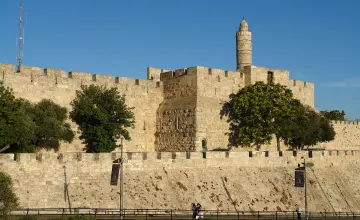Jerusalem's history stretches back about 5,000 years. About 2500 BC, the Canaanites inhabited the city. Later, Jerusalem became a Jebusite citadel. When DAVID captured the city (c.1000 BC), the Jebusites were absorbed into the Jewish people. David made Jerusalem the capital of his kingdom, and SOLOMON built the first Temple to house the Ark of the Covenant. In 586 BC, the Babylonian NEBUCHADNEZZAR II destroyed Jerusalem and the Temple and exiled the Jews to Babylonia.
Fifty years later (537 BC), CYRUS THE GREAT of Persia conquered Babylonia and permitted the Jews to return to Jerusalem and rebuild their Temple. Persia held the city until 333 BC, when ALEXANDER THE GREAT added Palestine to his empire. In 323 BC, PTOLEMY I of Egypt took Palestine into his kingdom.
About 198 BC, the Seleucid king ANTIOCHUS III conquered Judaea (of which Jerusalem was a part), making it tributary to Syria. The Jews later revolted under the leadership of Maccabees and defeated the Syrians. The Temple was reconsecrated in 165 BC, and the Maccabean, or Hasmonean, dynasty ruled until Rome took the city in 63 BC.
The Romans set up a local dynasty, the house of Herod, to rule most of Palestine; Herod the Great (r. 40-4 BC) rebuilt much of Jerusalem, including the Temple. Roman governors, however, retained ultimate control; one of them, Pontius Pilate, authorized the execution of Jesus Christ. While suppressing a major Jewish revolt, the Romans destroyed the Second Temple in AD 70. In 135, after the failure of the BAR KOCHBA revolt, Jews were banished from Jerusalem. From the early 4th century, when Christianity became legal in the Roman Empire, Jerusalem developed as a center of Christian pilgrimage.
The Church of the Holy Sepulcher and many other Christian shrines were erected. Except for a brief period of Persian rule (614-28) the city remained under Roman (later, Byzantine) control until 638, when the Muslim Arabs took Jerusalem. The Arabs built (688-91) the Dome of the Rock mosque on the site of the Temple.
In the 11th century, Muslim toleration of both Jews and Christians gave way to persecution under the FATIMID caliph al-Hakim (r. 996-1021) and under the SELJUKS, who seized Jerusalem in 1071. European Christendom responded by launching the CRUSADES. The Crusaders conquered Jerusalem in 1099 and established a Crusader state. SALADIN recaptured the city for the Muslims in 1187, and the Ayyubid and Mameluke dynasties ruled until 1517, when the Ottoman Empire took control.
In 1917 the British occupied Jerusalem, and it became the capital of mandated PALESTINE from 1923 until 1948. During this period the city saw Arab rioting against the Jews. The 1948 United Nations partition plan for Palestine called for internationalization of the city. The Arabs rejected this resolution, and, from 1949, Jerusalem was divided into an Israeli and a Jordanian sector. The city remained divided until 1967, when Israel took the entire city following the Six Day War. The city is reunited today under Israeli government, which guarantees religious freedom and protection of all holy places.






